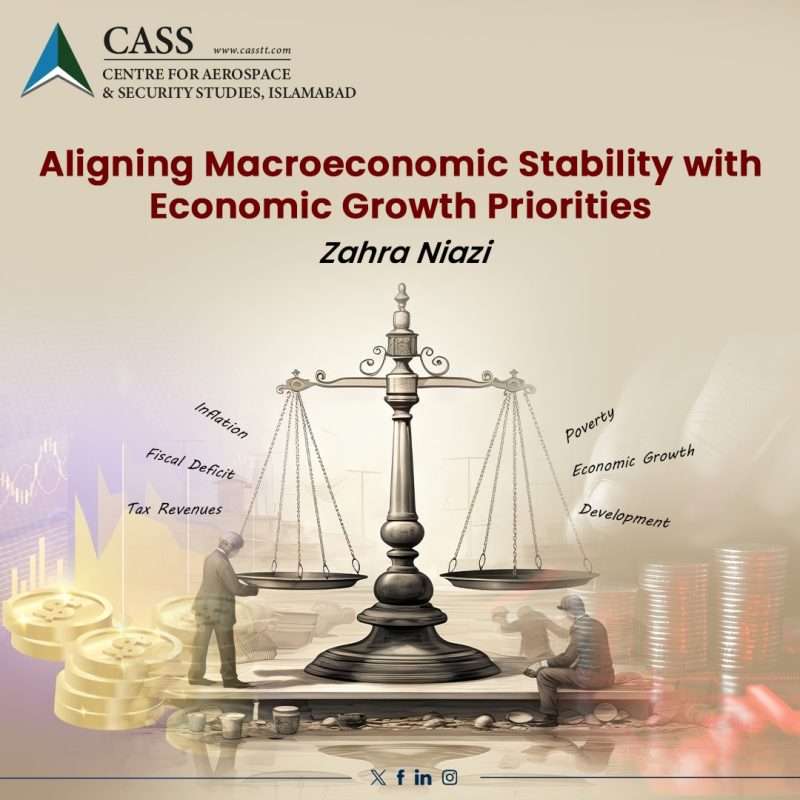The outgoing Fiscal Year (FY) 2023-24 was a transitional period for Pakistan’s economy. According to the Finance Division’s monthly ‘Economic Update and Outlook July 2024’, progress was observed across multiple domains, setting the basis for a better macroeconomic performance in the coming year.
The government’s fiscal deficit in July-May FY2024 reduced to 4.9% of the GDP compared to 5.5% the previous fiscal year. Federal Board of Revenue’s (FBR) tax revenues increased by 30%, and non-tax revenues increased by 90%. On the external account front, the current account deficit (CAD) shrank by USD 0.7 billion in FY2024 compared to USD 3.3 billion in FY2023. Average annual inflation fell from 29.2% to 23.4%, and exchange rate remained relatively stable after the first quarter. Additionally, the agricultural sector registered growth, while the large-scale manufacturing (LSM) sector expanded by 1.0% during July-May FY2024 after contracting by 9.0% the previous fiscal year. The Pakistan Stock Exchange (PSX) trended upwards from September 2023 onwards, and money supply increased by 15.5% compared to 14.2% in FY2023.
This outlook is encouraging and highlights the economy’s resilience, reinforced by the government’s response and IMF financing. However, closer examination of the underlying factors reveals that a part of macroeconomic stability can, at times, be achieved through measures that do not necessarily support long-term economic growth and productivity.
To provide a perspective – 90% increase in non-tax revenues in FY2024 is massive, attributed to the increased petroleum levy and higher State Bank of Pakistan (SBP) profits. In June 2023, the key interest rate set by the SBP reached a record high of 22% compared to 13.75% a year before. It remained steady at 22% till May 2024, allowing higher returns on interest-bearing loans, including for the SBP. In addition, commercial bank financing to the government spiked over the period, for which they also resorted to borrowing from the SBP, thus adding to the latter’s profits. However, from an economic growth perspective, a high interest rate is not a favoured monetary policy instrument. It makes borrowing more expensive and, hence, investments in the real economy less attractive – a hypothesis that has also been corroborated in the context of Pakistan. Secondly, large public sector debt is damaging in the long run, and reports suggest that government borrowing over the recent period contributed to crowding out private sector credit, which is a major engine of economic growth.
The other major source of non-tax revenues is the petroleum levy. It remains well-established that high fuel prices weaken economic growth. According to trade and industry leaders, increase in the cost of doing business due to a hike in petroleum prices has hampered economic activity in the country. High petroleum prices also affect consumer buying behaviour, leading to cuts in discretionary or non-essential spending.
Moreover, the Finance Division’s outlook report cites control over imports and increasing exports and remittances as contributing factors to improving Pakistan’s external account position. While strict import controls significantly lower the current account deficit, they also add costs to domestic producers relying on imported components and parts and promote inefficiencies within domestic industries, hurting growth and productivity.
Increase in exports and remittances is a positive development. However, the Asian Development Bank’s most recent report, ‘Understanding the Drivers of Remittances to Pakistan,’ cites high interest rate and the high inflation environment as two major drivers of remittance inflow in Pakistan – both of which can be detrimental to long-term economic growth. Research has concluded a non-linear relationship between economic growth and inflation, including in Pakistan, particularly when it crosses the double-digit figure. High inflation, for instance, is often associated with high volatility, which can hurt business confidence and lead to lower capital investment spending. Likewise, when inflation increases, individuals divert their energies to mitigating the effects of inflation rather than making investments that could raise their living standards or boost savings.
Macroeconomic stability is a fundamental precondition for economic growth, but achieving sustained growth necessitates that drivers of stability support and do not compromise long-term growth. Fiscal consolidation should come from broad-based expenditure reforms and an effective tax system characterised by equity, efficiency, certainty, simplicity, fairness, and flexibility. Improvement in the external account position should come from a sustainable increase in Foreign Direct Investment (FDI), exports, and remittances supported by factors that promote efficiency and productivity within the economy. Export growth, for instance, should be driven by an export-oriented strategy, including a reduction in trade barriers, and broad-based power sector reforms to enhance businesses’ competitiveness, which continue to be affected by rising electricity costs. Likewise, remittance growth should be supported by factors such as a dynamic and positive investment climate in the home country. The bottom line is that all means that contribute to macroeconomic stability must align with Pakistan’s economic growth priorities.
Zahra Niazi is a Research Assistant at the Centre for Aerospace & Security Studies (CASS), Islamabad, Pakistan. She can be reached at [email protected].





